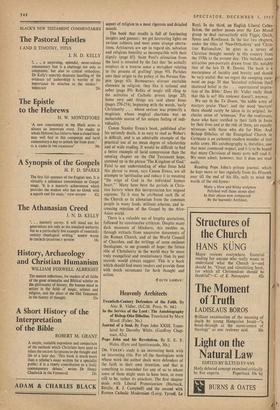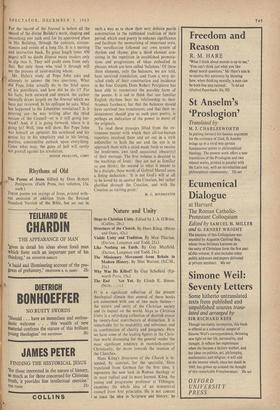Heavenly Architects
Twentieth-Century Defenders of the Faith. By Alec R. Vidler. (S.C.M. Press, 9s. 6d.)
DR. VIDLER's study is an interesting book with an interesting title. For all the theologians with whose work the author deals were defenders of the faith in their own intention, and that is something to remember for any of us to whom some of them might seem to have been, or even still to be, rather its attackers. The first chapter deals with Liberal Protestantism (Harnack, Renville, R. J. Campbell) and the second with Roman Catholic Modernism (Loisy, Tyrrell, Le Roy). In the third, on English Liberal Catho- licism, the author passes over the Lux Mundi group to deal instructively with Figgis, Quick, Spens and Rawlinson. In the last two chapters, under the titles of Isleo-Orthodoxy' and 'Chris- tian Rationalism,' he gives us a survey of Christian thought mainly in this country from the 1930s to the present day. This includes some attractive pen-portraits drawn from life, notably' that of the late D. R. Davies. The book is a masterpiece of lucidity and brevity and should be very useful. But we regret the sweeping state- ment on page 20 that 'historical criticism [has] shattered belief in the . . . supernatural inspira- tion of the Bible.' Does Dr. Vidler really think that this is so? His reviewer doesn't, anyway.
We say in the Te Dean?, 'the noble army of martyrs praise Thee'; and the word 'martyrs' there should surely be taken in its original, in- clusive sense of 'witnesses.' For the confessors, those who have testified to their faith in Jesus by their lives and at the risk of them, are equally witnesses with those who die for Him. And Bishop Dibelius of the Evangelical Church in Germany is an authentic modern member of that noble army. His autobiography is, therefore, one that must command respect, and it is to be hoped that many Christians of many sorts will read it. We must admit, however, that it does not read easily.
Reading Pope John's private journal, which be kept more or less regularly from his fifteenth year till the end of his life, calls to mind the words of the old hymn:
Many a blow and biting sculpture
Polished well those stones elect In their places now compacted By the heavenly Architect.
For the record of the Journal is before all the record of the divine Builder's work, shaping and smoothing one such soul for its appointed place in His Building, through the contacts, circum- stances and events of a long life. It is a moving and instructive book. Its great length (over 450 pages) will no doubt dispose many readers only to dip into it. They will profit even from only that. But only those who read it through will see the process of saint-making whole.
Mr. Hales's study of Pope John ,asks and attempts to answer the two questions, What did Pope John actually do in the brief space of his pontificate, and how did he do it? For his facts, both outward and inward, the author naturally draws largely on the Journal which we have just reviewed. In his epilogue he asks, What has happened to the Johannine revolution? Is it petering out—he was writing after the third session of the Council—or is it still going for- ward? And, if it is going forward, where is it going to? Well, time will show. But Pope John was himself an optimist; his sainthood and his genius lay in his simplicity and in his loving, Positive, constructive outlook upon everything. Come what may, the gates of hell will surely not prevail against his revolution.
SISTER PENELOPE, CSMV







































 Previous page
Previous page